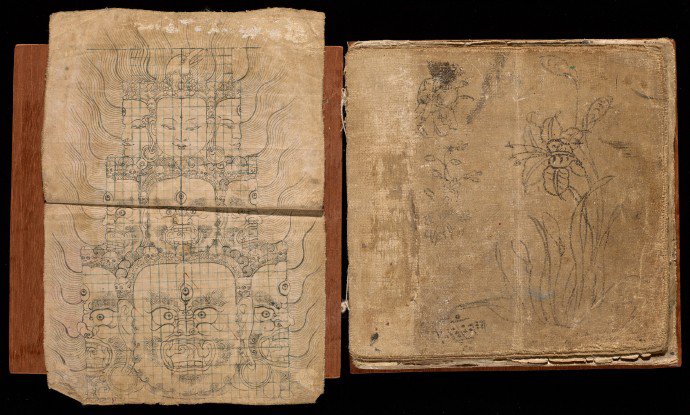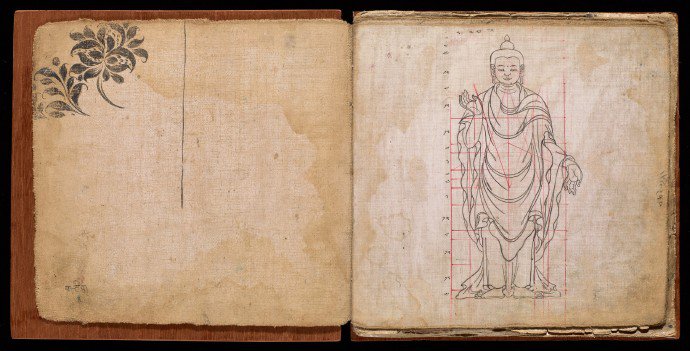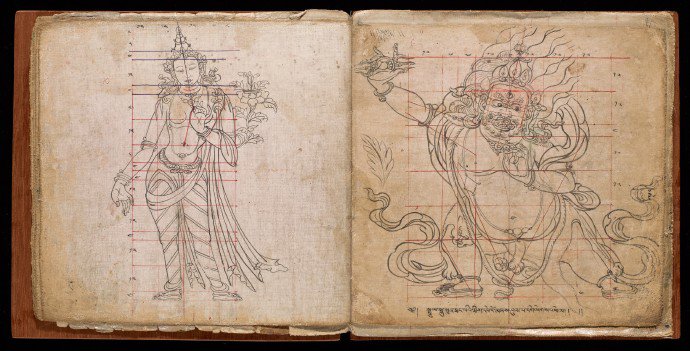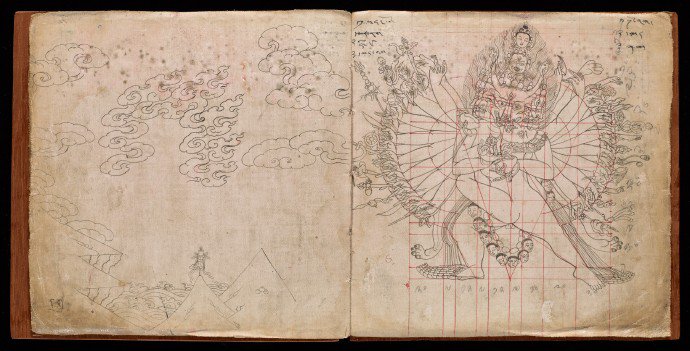36 measurements of Tibetan Buddhism figures
This 18th-century essay drawing is similar in content to the photographic measurements. The so-called “image measurement” is the scale of the Buddha’s human body and the scale of the figure.
This may be a reference guide for the painting of Buddha statues in Tibet or Nepal in the 18th century. It contains 36 detailed drawings and the text is in Tibetan.
The representation of the Buddhist figure is not fabricated out of thin air. The proportions, appearances, postures, decorations, etc. of the statutes or thangkas are strictly regulated and are included in the form of white paintings similar to those in the “figure of measurement”.
The unit of the scale used is the basic unit of the middle finger of the representation, which is the “one finger”. The Tibetan people have deified King Gesar and made him religious.
Obviously, the religious Gesar sculpture must follow the scale of the imagery measurement, because its creation comes from religion and tradition.
Table of Contents
- 1 - The Buddha’s statues are “three classics and one sparse”
- 2 - Modeling the Thangka
- 2.1 - First Page of the Book
- 2.2 - Flowers and clouds sketches
- 2.3 - Mahakala
- 2.4 - Decorative clouds in Thangka Painting
- 2.5 - Standing Sakyamuni Buddha
- 2.6 - Maitreya Buddha
- 2.7 - Shakyamuni Buddha with Ananda
- 2.8 - Buddha and Tara
- 2.9 - Monk
- 2.10 - Vajrayogini
- 2.11 - Manjushri standing and Vajra Kila
- 2.12 - Vishnu men, and Pupa King Kong
- 2.13 - Shengle King Kong
- 2.14 - Great Weide King Kong
- 2.15 - King Kong and Shengle King Kong
- 2.16 - Guru and Protector
- 2.17 - Avalokiteshvara on the right
- 2.18 - Buddha and Lohan
- 2.19 - Six-armed Mahakala and Two monks
- 2.20 - Protectors and Deity Figure
- 2.21 - Tara and Mahakala
- 2.22 - Red Tara Kurukulla
- 2.23 - End of the Book
The Buddha’s statues are “three classics and one sparse”
In the Tibetan Buddhist Scriptures, there are “three classics and one sparseness” in the work of the four classic Buddhist figures.
The “three classics and one sparse” have strict regulations on the proportions of Buddha, Bodhisattva, and the god of protection.
The book was translated into Chinese by the Buddhism General Manager Buchabu in the 7th year of Qing Emperor Qianlong (1742). The scriptures stipulated the measurements of Sakyamuni Buddha, as well as the proportions of various parts of the body and organs.
The “Analysis of the Imagery” is divided into three parts.
The chapter on “The ritual of welcoming the old figure” discusses the religious rituals that should be followed before the treatment of the broken Buddha figure.
“Drawing Measurements,” tells the theory of the gods and various secular figures.
“The Buddha says that the imagery is measured by the Shu”, also known as “The representation of the Buddha’s Body”, which is a commentary and detailed annotation of the Buddha’s illustrated Image.
Modeling the Thangka
First Page of the Book
Flowers and clouds sketches
Mahakala
Decorative clouds in Thangka Painting

Decorative clouds in Thangka Painting
Standing Sakyamuni Buddha
Maitreya Buddha
Shakyamuni Buddha with Ananda
Buddha and Tara
Monk
Vajrayogini
Manjushri standing and Vajra Kila
Vishnu men, and Pupa King Kong
Shengle King Kong
Great Weide King Kong
King Kong and Shengle King Kong
Guru and Protector
Avalokiteshvara on the right
Buddha and Lohan
Six-armed Mahakala and Two monks
Protectors and Deity Figure
Tara and Mahakala
Red Tara Kurukulla
End of the Book

































